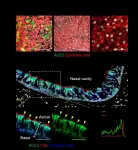(Press-News.org) The number of people who live past the age of 100 has been on the rise for decades, up to nearly half a million people worldwide.
There are, however, far fewer "supercentenarians," people who live to age 110 or even longer. The oldest living person, Jeanne Calment of France, was 122 when she died in 1997; currently, the world's oldest person is 118-year-old Kane Tanaka of Japan.
Such extreme longevity, according to new research by the University of Washington, likely will continue to rise slowly by the end of this century, and estimates show that a lifespan of 125 years, or even 130 years, is possible.
"People are fascinated by the extremes of humanity, whether it's going to the moon, how fast someone can run in the Olympics, or even how long someone can live," said lead author Michael Pearce, a UW doctoral student in statistics. "With this work, we quantify how likely we believe it is that some individual will reach various extreme ages this century."
Longevity has ramifications for government and economic policies, as well as individuals' own health care and lifestyle decisions, rendering what's probable, or even possible, relevant at all levels of society.
The new study, published June 30 in Demographic Research, uses statistical modeling to examine the extremes of human life. With ongoing research into aging, the prospects of future medical and scientific discoveries and the relatively small number of people to have verifiably reached age 110 or older, experts have debated the possible limits to what is referred to as the maximum reported age at death. While some scientists argue that disease and basic cell deterioration lead to a natural limit on human lifespan, others maintain there is no cap, as evidenced by record-breaking supercentenarians.
Pearce and Adrian Raftery, a professor of sociology and of statistics at the UW, took a different approach. They asked what the longest individual human lifespan could be anywhere in the world by the year 2100. Using Bayesian statistics, a common tool in modern statistics, the researchers estimated that the world record of 122 years almost certainly will be broken, with a strong likelihood of at least one person living to anywhere between 125 and 132 years.
To calculate the probability of living past 110 -- and to what age -- Raftery and Pearce turned to the most recent iteration of the International Database on Longevity, created by the Max Planck Institute for Demographic Research. That database tracks supercentenarians from 10 European countries, plus Canada, Japan and the United States.
Using a Bayesian approach to estimate probability, the UW team created projections for the maximum reported age at death in all 13 countries from 2020 through 2100.
Among their findings:
Researchers estimated near 100% probability that the current record of maximum reported age at death -- Calment's 122 years, 164 days -- will be broken;
The probability remains strong of a person living longer, to 124 years old (99% probability) and even to 127 years old (68% probability);
An even longer lifespan is possible but much less likely, with a 13% probability of someone living to age 130;
It is "extremely unlikely" that someone would live to 135 in this century.
As it is, supercentenarians are outliers, and the likelihood of breaking the current age record increases only if the number of supercentenarians grows significantly. With a continually expanding global population, that's not impossible, researchers say.
People who achieve extreme longevity are still rare enough that they represent a select population, Raftery said. Even with population growth and advances in health care, there is a flattening of the mortality rate after a certain age. In other words, someone who lives to be 110 has about the same probability of living another year as, say, someone who lives to 114, which is about one-half.
"It doesn't matter how old they are, once they reach 110, they still die at the same rate," Raftery said. "They've gotten past all the various things life throws at you, such as disease. They die for reasons that are somewhat independent of what affects younger people.
"This is a very select group of very robust people."
INFORMATION:
The study was funded by the National Institute for Child Health and Human Development.
For more information, contact Pearce at mpp790@uw.edu or Raftery at raftery@uw.edu.
In Canada, low-income hospital patients under palliative care are less likely to receive medical assistance in dying compared to those who are high income, according to a study published in British Medical Journal Open (BMJ Open).
Medical assistance in dying (MAID) is legal and free under Medicare, Canada's universal health care system. Patients with low socioeconomic status (SES), however, generally tend to experience less access to medical care compared to their high SES counterparts.
Eldar Shafir, professor of psychology and public affairs at the Princeton School of Public and International Affairs, along ...
Imaging spectroscopy can help predict water stress in wild blueberry barrens, according to a University of Maine-led study.
The technology involves measuring the light reflected off of objects depicted in images captured by drones, satellites and other remote sensing technology to classify and gather pertinent information about the objects. According to researchers, it can precisely measure light across dozens, if not hundreds, of bands of colors. The reflectance spectra can depict nutrient levels, chlorophyll content and other indicators of health for various crops, according to researchers.
Scientists from UMaine, the Schoodic Institute and Wyman's, one of the world's largest purveyors of wild blueberries and ...
More than 80 percent of people around the world consider themselves to be religious or spiritual. But research on the neuroscience of spirituality and religiosity has been sparse. Previous studies have used functional neuroimaging, in which an individual undergoes a brain scan while performing a task to see what areas of the brain light up. But these correlative studies have given a spotty and often inconsistent picture of spirituality. A new study led by investigators at Brigham and Women's Hospital takes a new approach to mapping spirituality and religiosity and finds that spiritual acceptance can be localized to a specific brain circuit. This brain circuit is centered in the periaqueductal gray (PAG), a brainstem region that has been implicated ...
Over the last two decades, biomaterials research has made significant progress, transitioning from traditional biomaterials to biomaterials with controlled structure and dynamic functionality. A number of building blocks have been explored for developing biomaterials by self-assembly, but SAPs have garnered special attention due to their tunability and potential use in various applications such as tissue engineering, wound healing, and vaccinations. Despite these benefits, the SAP-based approach is less explored in the intracellular context.
Fortunately, a team of scientists from the Tokyo Institute of Technology (Tokyo Tech), led by Assistant Prof. Takayuki Miki, have reported a de novo peptide, Y15, that ...
Boulder, Colo., USA: The Geological Society of America regularly publishes
articles online ahead of print. GSA Bulletin topics include
multiple articles about the dynamics of China and Tibet; the end-Permian
terrestrial extinction paradigm in South Africa; prehistoric lava flows
from the urban district of Catania (Etna volcano, Italy); the debated
origins of granite, and "a tale of two Tweefonteins." You can find these
articles at
https://bulletin.geoscienceworld.org/content/early/recent
.
Authigenic berthierine and incipient chloritization in shallowly ...
Most babies born prematurely or with health problems are quickly whisked away to the Neonatal Intensive Care Unit (NICU) where they might require assisted heating devices to regulate their temperature. A University of Houston College of Nursing researcher is reporting that the traditional use of cloth blankets and towels during peripherally inserted central catheter (PICC) placement may hinder heat transfer from the assisted heating mechanisms, increasing the risk for neonatal hypothermia. In Advances in Neonatal Care, Huong (Kelle) Phan, clinical assistant professor, reports that a plastic drape lowers the incidence of hypothermia.
"The use of the plastic drape is a quality improvement to reduce the hypothermia rate in very low birth-weight ...
WILMINGTON, Del. (June 29, 2021) - A new report finds that 509,025 (9.17%) public high school students in 24 states experienced homelessness in spring 2019 -- three times the number recognized by the states' education agencies. This under-recognition creates gaps in funding and services needed by this vulnerable population.
Researchers from Nemours Children's Health and the University of Pennsylvania analyzed data from the Centers for Disease Control and Prevention (CDC) for public schools across 24 states and 12 school districts. During spring 2019, more than 9% of public high school students experienced homelessness during a 30-day period in the 24 states. The rate was even higher in the 12 school ...
New research published today in the journal Blood Advances finds that certain factors, such as a history of severe pain episodes and coexisting organ conditions, increase the risk of severe COVID-19 illness, including hospitalization, in individuals living with sickle cell disease (SCD). According to researchers, the study results underscore the need for COVID-19 risk reduction strategies and vaccination for this medically vulnerable population.
SCD is the most common inherited red blood cell disorder in the United States, affecting an estimated 100,000 people. According to the Centers for Disease Control and Prevention, SCD affects one out of ...
Understanding how viral infection occurs can provide important clues for researchers to develop strategies to prevent viral transmission and develop effective therapeutic agents and vaccines. SARS-CoV-2, the causative agent of COVID-19, enters the host cells through interaction between the virus's spike protein and the extracellular receptor binding domain of ACE2. The viral entry into the cells is completed by various proteases, which allow the viral and cell membranes to fuse together. While it is known that the upper respiratory tract becomes compromised in the early infection, the exact types of the cells that the virus infects at the earliest stage have not yet been identified.
Led by Director ...
New research from the Institute of Psychiatry, Psychology & Neuroscience (IoPPN) at King's College London, in collaboration with the University of Liverpool and the Karolinska Institute, has shown that many of the symptoms in fibromyalgia syndrome (FMS) are caused by antibodies that increase the activity of pain-sensing nerves throughout the body.
The results show that fibromyalgia is a disease of the immune system, rather than the currently held view that it originates in the brain.
The study, published today in the Journal of Clinical Investigation, demonstrates that the increased ...



